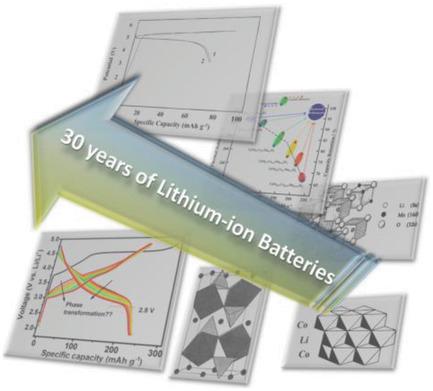当前位置:
X-MOL 学术
›
Adv. Mater.
›
论文详情
Our official English website, www.x-mol.net, welcomes your feedback! (Note: you will need to create a separate account there.)
30 Years of Lithium‐Ion Batteries
Advanced Materials ( IF 29.4 ) Pub Date : 2018-06-14 , DOI: 10.1002/adma.201800561 Matthew Li 1, 2 , Jun Lu 1 , Zhongwei Chen 2 , Khalil Amine 1, 3, 4
Advanced Materials ( IF 29.4 ) Pub Date : 2018-06-14 , DOI: 10.1002/adma.201800561 Matthew Li 1, 2 , Jun Lu 1 , Zhongwei Chen 2 , Khalil Amine 1, 3, 4
Affiliation

|
Over the past 30 years, significant commercial and academic progress has been made on Li‐based battery technologies. From the early Li‐metal anode iterations to the current commercial Li‐ion batteries (LIBs), the story of the Li‐based battery is full of breakthroughs and back tracing steps. This review will discuss the main roles of material science in the development of LIBs. As LIB research progresses and the materials of interest change, different emphases on the different subdisciplines of material science are placed. Early works on LIBs focus more on solid state physics whereas near the end of the 20th century, researchers began to focus more on the morphological aspects (surface coating, porosity, size, and shape) of electrode materials. While it is easy to point out which specific cathode and anode materials are currently good candidates for the next‐generation of batteries, it is difficult to explain exactly why those are chosen. In this review, for the reader a complete developmental story of LIB should be clearly drawn, along with an explanation of the reasons responsible for the various technological shifts. The review will end with a statement of caution for the current modern battery research along with a brief discussion on beyond lithium‐ion battery chemistries.
中文翻译:

锂离子电池30年
在过去的30年中,基于锂的电池技术取得了重大的商业和学术进步。从早期的锂金属阳极迭代到目前的商用锂离子电池(LIB),基于锂的电池的故事充满了突破和追溯步骤。本文将讨论材料科学在LIBs开发中的主要作用。随着LIB研究的进展和感兴趣的材料的变化,对材料科学的不同子学科的重视也有所不同。早期关于LIB的研究更多地集中在固态物理学上,而在20世纪末,研究人员开始更多地关注电极材料的形态学方面(表面涂层,孔隙率,大小和形状)。尽管很容易指出目前哪种特定的正极和负极材料是下一代电池的理想选择,但很难确切说明为什么选择它们。在这篇综述中,应该为读者清晰地画出完整的LIB发展故事,并解释造成各种技术变化的原因。审查将以对当前现代电池研究的警告声明结束,并对锂离子电池以外的化学物质进行简短讨论。
更新日期:2018-06-14
中文翻译:

锂离子电池30年
在过去的30年中,基于锂的电池技术取得了重大的商业和学术进步。从早期的锂金属阳极迭代到目前的商用锂离子电池(LIB),基于锂的电池的故事充满了突破和追溯步骤。本文将讨论材料科学在LIBs开发中的主要作用。随着LIB研究的进展和感兴趣的材料的变化,对材料科学的不同子学科的重视也有所不同。早期关于LIB的研究更多地集中在固态物理学上,而在20世纪末,研究人员开始更多地关注电极材料的形态学方面(表面涂层,孔隙率,大小和形状)。尽管很容易指出目前哪种特定的正极和负极材料是下一代电池的理想选择,但很难确切说明为什么选择它们。在这篇综述中,应该为读者清晰地画出完整的LIB发展故事,并解释造成各种技术变化的原因。审查将以对当前现代电池研究的警告声明结束,并对锂离子电池以外的化学物质进行简短讨论。


























 京公网安备 11010802027423号
京公网安备 11010802027423号